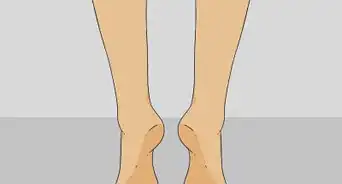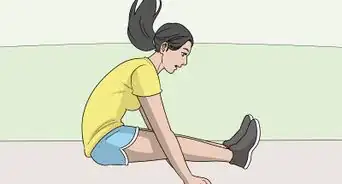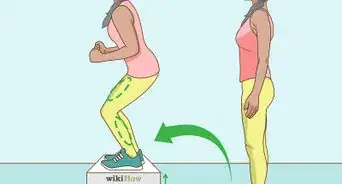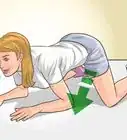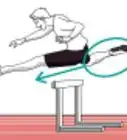This article was co-authored by Francisco Gomez and by wikiHow staff writer, Danielle Blinka, MA, MPA. Francisco Gomez is the Head Coach at the FIT Potato Gym, a training gym established in 2001 in the San Francisco Bay Area. Francisco is a former competitive runner who helps endurance athletes train for major marathons like the Boston Marathon. Francisco specializes in Injury Rehab, Flexibility, Marathon Training, and Senior Fitness. He has a B.S. in Nutrition and Exercise Physiology & Running.
wikiHow marks an article as reader-approved once it receives enough positive feedback. This article received 14 testimonials and 85% of readers who voted found it helpful, earning it our reader-approved status.
This article has been viewed 2,318,122 times.
If you’re an athlete, then working to increase your vertical leap could help you go further in your sport. A strong vertical leap can help you excel in several sports, including basketball, gymnastics, and volleyball. It will also help to improve your overall athleticism and flexibility. Increasing your vertical leap is possible with calisthenics, plyometrics, and weight training.
Steps
Plyometrics
-
1Do plyometric exercises to build up your leg muscles. Plyometric exercises are one of the best ways to improve your vertical leap. These exercises use explosive force to train and build your muscles. These exercises all incorporate jumping and rely on your body weight to achieve results.[1]
- Limit your plyometric workouts to twice a week with at least two days of rest between workouts.
- Give yourself at least one full rest day per week.
Tip: On off days from your plyometric workouts, you can do an alternate workout, such as cardio, weight lifting, and/or calisthenics.
-
2Perform jump squats.[2] Place your feet hip-width apart, and squat as low as you can. Instead of rising back up slowly, though, jump from squatting position and try to turn 180 degrees. Come down from the jump in another squat––don't try to land standing straight up. Repeat, changing directions when you jump. For instance, turn to the right the first time, then turn to the left, and so on.[3]
- Do 3 sets of 5 until it feels easy, then increase to 3 sets of 8.
Advertisement -
3Do Bulgarian split squats. Stand a few steps away from a bench or chair, and place your non-working leg up on the seat with the top of your foot flat on the seat of the chair. Lower your body until your back knee is nearly touching the floor, then push back up through the heel of your front foot that is on the floor. This is one rep.[4]
- Do 3 sets of 8 reps.
-
4Perform box jumps.[5] Get a sturdy box or platform that will hold your weight. Place the box in front of you. Explosively jump up onto the box or platform. Use as much power as possible. Jump back down and land in a crouching position.
- Start with 3 reps. Focus on intensity rather than quantity.
-
5Jump rope. Jumping rope strengthens the muscles you need to execute a vertical leap and helps improve your jumping abilities. Jump on a firm surface, such as hardwood floor, where there’ll be plenty of room over your head for the rope. Jump for ten minutes per day. If you can’t do it all at once, you can break it up into two to three minute jumping segments, broken up by resting periods and/or other exercises.[6]
- Don't "skip" rope, where you essentially jump with one foot in a sort of running-in-place motion. Instead, try to keep your ankles together as you jump with both feet at the same time.
- As you improve, jump faster. You might start out moving the rope slowly, taking a small hop between jumps to maintain your balance. When you're ready, move the rope more quickly and get rid of the balance hop.
Calisthenics
-
1Perform calisthenics every day to increase flexibility. Calisthenics includes basic bodyweight exercises that help build up your muscles. Because you don’t need any equipment, you can do calisthenics anywhere to build strength and agility. To improve your vertical leap, do calisthenics that target your leg muscles.
- Some examples of calisthenics include push-ups, jumping jacks, sit-ups, and lunges.
Note: You can do calisthenics daily, but take at least one rest day per week.
-
2Stretch daily. Not only will stretching help protect your body during the rest of your workout, it will also improve your jumping abilities by loosening your muscles.
-
3Perform calf raises. Stand with your legs together. Lift yourself onto your toes, then lower yourself down. Move slowly to make the muscles work harder.[7]
- For better results, stand on the edge of a curb or a step.
- Start with 20 reps, increasing as the move gets easier.
-
4Do deep squats. Place your feet hip-width apart, and keep your heels flat on the ground. Slowly lower yourself as far as you can by simply bending your knees while keeping your back erect and your neck straight. Lift back up to starting position.[8]
- Your thighs should go below your knee when doing a deep squat.
- A good squat should feel like it's working the entire lower half of your body, as well as stretching the core muscles around your back and abdomen.
- Start out with 3 sets of 10 squats.
- Do some squats while keeping your weight on your tiptoes. This will help you strengthen your ankles.
-
5
-
6Stand on one leg. Alternate standing on each of your legs so that your ankles become stronger. This may help to prevent you from getting an ankle injury when you land your jumps. Stand up straight and focus on an object straight ahead of you. Bring one foot off of the ground and hold this position until your leg starts to get tired. Then switch your weight to the other leg and repeat this process.
Weight Training
-
1Do weight training to build up the strength of your leg muscles. Strengthening your leg muscles can improve your jumping abilities. Weight exercises that target your leg muscles will help you improve your vertical leap.
- Do weight training two to three times per week.
Note: Rest at least one day between weight lifting days. On your off days from lifting, you can do an alternate workout. However, do take at least one rest day per week.
-
2Do trap bar deadlifts. Trap bars are different from regular barbells because they have an open center that allows the user to step inside. You will stand inside the center of the barbell. Bend down, grasp the barbell, and stand up. Lift the trap bar as you rise, keeping the barbell close your body as you rise. Keep your arms at your sides. Hold the weight for a moment, then lower it.[10]
- Your deadlift weights should be as heavy as you can lift.
- Keep the bar close to your body and your arms extended down. Don’t lock your elbows.
-
3Try single-arm dumbbell snatches. Place a dumbbell down on the floor in front of you. Squat down and grasp the dumbbell with one hand. Stand up, lifting the dumbbell as you rise. Extend your dumbbell above your head. Hold, then lower the weight back to the starting position.[11]
- Do 3 sets of 8 reps.
- Start with a low weight and focus on your speed.
-
4Do weighted squats. Place your feet hip-width apart. Lift a barbell or two dumbbells up to your shoulders and rest them on your shoulders. Lower yourself as far down as you can, maintaining the weights in position. Rise back into standing position.[12]
- Do 3 sets of 8.
- If using dumbbells, start with 5-lb (2.25 kg) weights, then progress to 7- (3 kg) to 8-lb (3.5 kg) weights.
- If using a barbell, start with just the bar.
Tracking Your Vertical Leap
-
1Practice your jump. Every few days, try a few vertical leaps to track your progress. Don't focus on vertical leaps as your primary means of training, though; doing them over and over will result in slower progression than doing targeted exercises to prime your body for athletic performance.[13]
-
2Measure your current vertical leap. Stand near a tall wall or pole and raise your hand as far as you can. Have a friend measure where your hand reaches up to (make a mark with chalk or a similar marking tool). Then jump with that same hand raised, and have your friend try to measure where your fingertips hit the wall. Subtract your original measurement from your jump measurement. This is your current vertical leap.[14]
Tip: Try wetting or putting chalk dust on your fingertips so that you can leave a mark on the wall or pole to make measuring easier.
-
3Choose a way to track your increases. You'll need to keep track of your measurements and when they were taken. Write the date you took the measurements and how high you jumped. There are several options for tracking your measurements, depending on your preferences. You could use paper, your computer, or your phone.
- Keep it simple by writing down your numbers.
- Type your numbers into a document or spreadsheet if you prefer to use the computer.
- Keep track of the numbers on your phone in the notes app or a word processing app.
-
4Take new measurements weekly. How often you measure your vertical leap is up to you, but measuring weekly will provide consistency and allow time for improvements between measurements.
- If you forget to measure on your normal day, measure the next time you get a chance.
Expert Q&A
Did you know you can get expert answers for this article?
Unlock expert answers by supporting wikiHow
-
QuestionWill jumping every day increase my vertical?
 Francisco GomezFrancisco Gomez is the Head Coach at the FIT Potato Gym, a training gym established in 2001 in the San Francisco Bay Area. Francisco is a former competitive runner who helps endurance athletes train for major marathons like the Boston Marathon. Francisco specializes in Injury Rehab, Flexibility, Marathon Training, and Senior Fitness. He has a B.S. in Nutrition and Exercise Physiology & Running.
Francisco GomezFrancisco Gomez is the Head Coach at the FIT Potato Gym, a training gym established in 2001 in the San Francisco Bay Area. Francisco is a former competitive runner who helps endurance athletes train for major marathons like the Boston Marathon. Francisco specializes in Injury Rehab, Flexibility, Marathon Training, and Senior Fitness. He has a B.S. in Nutrition and Exercise Physiology & Running.
Fitness Coach
-
QuestionWhat does your vertical have to be to dunk?
 Michele DolanMichele Dolan is a BCRPA certified Personal Trainer in British Columbia. She has been a personal trainer and fitness instructor since 2002.
Michele DolanMichele Dolan is a BCRPA certified Personal Trainer in British Columbia. She has been a personal trainer and fitness instructor since 2002.
Certified Fitness Trainer
-
QuestionI weigh 165 pounds and I'm 5 feet and 11 inches tall. How can I get a better vertical?
 Michele DolanMichele Dolan is a BCRPA certified Personal Trainer in British Columbia. She has been a personal trainer and fitness instructor since 2002.
Michele DolanMichele Dolan is a BCRPA certified Personal Trainer in British Columbia. She has been a personal trainer and fitness instructor since 2002.
Certified Fitness Trainer
Warnings
- Don't overexert yourself. Allow yourself to rest and recover from any injuries before you reassess your training methods.⧼thumbs_response⧽
- Check with your doctor or athletic trainer before beginning any new exercise regimens.⧼thumbs_response⧽
References
- ↑ https://www.ncbi.nlm.nih.gov/pmc/articles/PMC2465309/
- ↑ Francisco Gomez. Fitness Coach. Expert Interview. 24 October 2019.
- ↑ http://www.stack.com/a/4-proven-strategies-to-increase-your-vertical-jump-for-basketball
- ↑ http://www.mensfitness.com/training/pro-tips/4-tips-increasing-your-vertical-jump
- ↑ Francisco Gomez. Fitness Coach. Expert Interview. 24 October 2019.
- ↑ http://www.stack.com/a/4-proven-strategies-to-increase-your-vertical-jump-for-basketball
- ↑ https://www.coachup.com/nation/articles/basketball-training-increase-your-ve
- ↑ http://www.stack.com/a/4-proven-strategies-to-increase-your-vertical-jump-for-basketball
- ↑ Francisco Gomez. Fitness Coach. Expert Interview. 24 October 2019.
- ↑ https://www.usab.com/youth/news/2011/09/3best-exercises-for-the-vertical-jump.aspx
- ↑ https://www.usab.com/youth/news/2011/09/3best-exercises-for-the-vertical-jump.aspx
- ↑ http://www.stack.com/a/4-proven-strategies-to-increase-your-vertical-jump-for-basketball
- ↑ http://www.stack.com/a/4-proven-strategies-to-increase-your-vertical-jump-for-basketball
- ↑ http://www.stack.com/a/4-proven-strategies-to-increase-your-vertical-jump-for-basketball
About This Article
One way to increase your vertical leap is by doing calisthenics every day. To improve your flexibility and muscle strength, do bodyweight exercises such as push ups, jumping jacks, sit-ups, and lunges. Throughout your workouts, focus on stretching and strengthening your legs by doing toe touches, calf raises, and deep squats. The best way to increase the height of your leap is by doing jumping exercises, like jump squats, box jumps, and even jumping rope. For more information, including specific instructions for each exercise, read on!


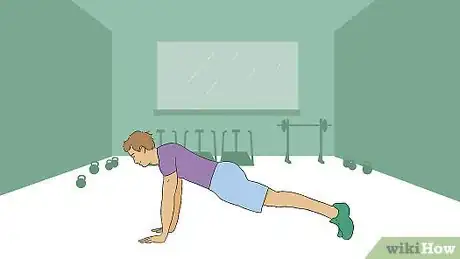

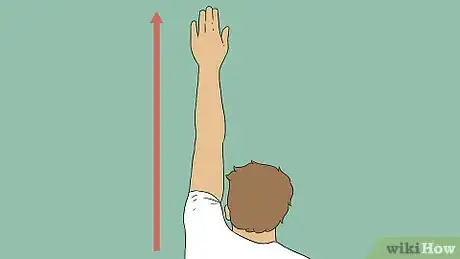


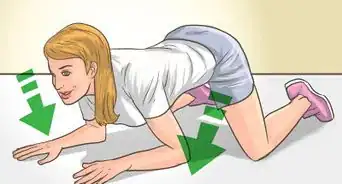

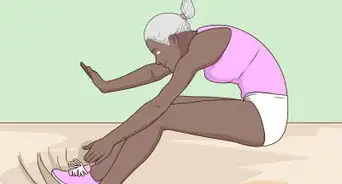
-Step-15-Version-2.webp)

